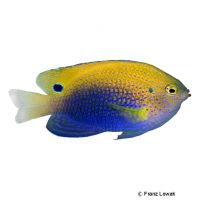Princess Damselfish (Pomacentrus vaiuli)
| Princess Damselfish Pomacentrus vaiuli | |
|---|---|
| Name | Princess Damselfish |
| Name Lat. | Pomacentrus vaiuli |
| Family | Damselfishes |
| Family lat. | Pomacentridae |
| Order | Ovalentarias |
| Order lat. | Ovalentaria inc. sed. |
| Origin | Western Pacific |
| Habitat | Lagoons, seaward reefs |
| Diet | Omnivore |
| pH | 8.1-8.4 |
| Hardness | 8-10 °KH |
| Behavior | Semi-aggressive |
| Keeping | Individual |
| Reef Compatible | Yes |
| Care Level | Moderate |
| Life Span | N/A |
| Protection | No |
| Metric Units | |
| Size | 10 cm |
| Temperature | 22-28 °C |
| Salinity | 33-36 ‰ |
| Aquarium | ~ 250 l |
| US Units | |
| Size | 4" |
| Temperature | 72-82 °F |
| Salinity | 1.020-1.025 sg |
| Aquarium | ~ 65 gal |
Distribution and habitat
The distribution area of Pomacentrus vaiuli is the western Pacific Ocean, from the Moluccas (Indonesia) to Samoa and Tonga. They live there in coral-rich lagoons and on outer reefs up to 40 m depth.
Maintenance
They need a well-structured aquarium with a reef structure that allows for territoriality (crevices, caves, shelters), with live stones that they can graze on (small crustaceans, algae) and that act as a biological filter, as well as free sand areas. Only lime-rich, heavy metal-free sands, gravels, stones or sea sand of various grain sizes may be used as substrate
Filters, skimmers and heaters are necessary to ensure water quality, as well as pumps to simulate tides, swells and bottom currents. Lighting must correspond to the species-appropriate day-night rhythm of the animals
| Salinity: 33-36 ‰ | pH value: 8.1-8.4 |
| Carbonate hardness: 8-10 °KH | Nitrate content: 2-8 mg/l |
| phosphate content: 0.01-0.1 mg/l | nitrite content: 0.0-0.05 mg/l |
For salinity, an average value should be aimed for, which may only vary slightly by +/- 0.5 ‰. Ammonia and ammonium must not be measurable. Special attention must be paid to constantly good water quality.
Diet
They feed mainly on zooplankton and algae. The feed change usually succeeds without problems. The food supply should consist of a combination of live and frozen food, such as small mysis, krill, gammarus, cyclops and artemia, with small cut squid and mussel meat or a commercially available, vitamin-enriched frozen food mix for plankton eaters. For this they need algae leaves or seaweed (e.g. spirulina, kelp). High-quality dry food in flake or granule form is also usually well accepted
It is recommended to feed small portions several times a day (3-5 times). Regular and varied feeding promotes health and increases resistance.
Behaviour and compatibility
Adults are usually aggressive within the species. They form a small territory around their living caves, which is defended. Keeping in pairs is only recommended in a larger, very strongly structured aquarium. To avoid turf wars, one pair should be added to the aquarium at a time. To other fish they are peaceful, but consistently defend their territory.
Sex dimorphism
There are no known external distinguishing characteristics.
Reproduction and breeding
There are no known reports of successful breeding in the aquarium.
Important
They come in different color forms according to their origin
As coral reef dwellers, they should not be kept in a fish-only aquarium.
If different species are kept together, care should be taken to ensure that the fish match each other in terms of water quality and temperature requirements and social behavior, and that the setup meets the needs of all species kept together. New fish to be introduced must be acclimated slowly to the water in the aquarium
Further literature can be found in your pet store.
References
Text: Werner Winter; Image: Franz Lowak
Source: KUITER & DEBELIUS (2007): Atlas der Meeresfische: Die Fische an den Küsten der Weltmeere, Kosmos Verlag; BAENSCH & PATZNER (1998): Meerwasser Atlas Bd. 7, Mergus Verlag; ENGELMANN (2005): Zootierhaltung - Tiere in menschlicher Obhut: Fische, Verlag Harri Deutsch
- Gemäß § 21 Abs. 5 Tierschutzgesetz idgF
